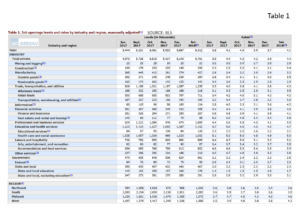Job Turnover and Openings Report
Businesses have a mountain of jobs to fill, another data point on just how strong the economy is at the present time. Job openings increased to 6.31 million, (+645,000) on the last business day of January according to the Bureau of Labor Statistics. Of the increased openings, 608,000 were in the private sector. The job opening rate increased to 4.1% in January. Over the month, hires were little changed at 5.58 million, while separations were also little changed 5.41 million.
The job openings and labor turnover survey serves as a demand-side indicator of labor shortages at the national level. Data on job openings, hires, quits, layoffs and discharges, and other separations are based on a sample of approximately 16,400 establishments and cover all nonfarm establishments in the private sector as well as federal, state, and local governments in the 50 states and the District of Columbia. Levels and rates are calculated for each category. The rate is the level as a percent of total employment. For job openings, the rate is computed as the number of openings as a percent of employment plus openings. The data are useful in determining what is behind the net numbers released in the monthly report.
Job openings increased across most industries to include professional services, transportation, warehousing, utilities and construction. Government job openings edged higher. Separations on the other hand barely budged. The quit rate fell month on month by 0.1 point to 2.2% as the layoff rate ticked up 0.1 point to 1.2%. On a regional basis, the job opening rate was highest in the Midwest at 4.6%, up from 4% in December. The openings rate was also above 4% in the West, coming in at 4.3%, vs. 3.8% in December. The openings rate was 3.9% in the South and 3.6% in the Northeast. The quits rate was the highest in the South (2.5%) and the lowest in the Northeast (1.6%).
Examining the job openings that most impact demand for long products steel consumption, we see that: In Construction, the current number of openings is 250,000, up from 159,000 in January 2017. Manufacturing job openings totaled 427,000 in January up from 365,000 last year at this time. The “Durable Goods” category had 284,000 openings compared to 202 a year ago, while “non-Durable Goods” had 143,000 openings 20,000 lower year on year.
 Table 1 breaks down the complete seasonally adjusted job openings, hires and total separations by industry in addition to a regional summary.
Table 1 breaks down the complete seasonally adjusted job openings, hires and total separations by industry in addition to a regional summary.
The labor market fundamentals remain remarkably healthy into the ninth year of steady expansion. However, businesses are having an increasingly difficult time finding qualified workers. The economy needs to add around 100,000 jobs per month this year to keep up with growth in the working-age population. From this it appears that the unemployment rate will reach 3.5% by the end of this year,
At Gerdau, we keep a keen eye on the employment numbers because we have demonstrated that there is an excellent correlation between employment levels and steel consumption. High job creation and low unemployment translate to strong steel demand and vice versa.

